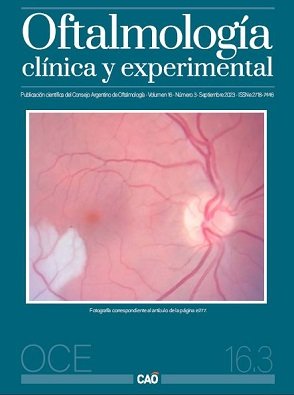Lacrimal intubation techniques and traumatism
DOI:
https://doi.org/10.70313/2718.7446.v16.n03.249Keywords:
lacrimal duct, lacrimal duct intubation, lacrimal duct alteration, lacrimal stent, Mini-Monoka™Abstract
Objective: The lacrimal canaliculi are structures very prone to suffer damage caused by traumas, which if not repaired in a timely manner can cause sequelae. The objective is to describe basic aspects of surgical techniques for intubation of the lacrimal duct.
Surgical technique: Three intubation options are proposed. One is monocanalicular, by placing a silicone stent, with or without a metallic tutor, through the lacrimal punctum, connecting the proximal and distal portion of the injured canaliculus with the lacrimal sac. Annular bicanalicular intubation, which is through the healthy lacrimal punctum and canaliculus where a silicone stent is placed with a suture inside it, connecting the superior canaliculus with the inferior one. The third option is nasal bicanalicular intubation, where a silicone stent is placed in both canaliculi and through the opening of the lacrimal sac they are conducted through the nasolacrimal duct to the nostril.
Conclusion: Three options for lacrimal duct intubation have been described. Considering that any canalicular laceration must be repaired, it is essential to be familiar with these techniques and to know the anatomy in order to make a correct approach to the lacrimal duct and preserve its drainage function.
Downloads
References
Ali MJ, Paulsen F. Human lacrimal drainage system reconstruction, recanalization, and regeneration. Curr Eye Res 2020; 45: 241–252.
Han J, Chen H, Wang T et al. A case series study of lacrimal canalicular laceration repair with the bi-canalicular stent. Gland Surg 2022; 11: 1801-1807.
Rishor-Olney CR, Hinson JW. Canalicular laceration. En: StatPearls [en línea]. Treasure Island (Florida): StatPearls Publishing, 2023.
Ko AC, Satterfield KR, Korn BS, Kikkawa DO. Eyelid and periorbital soft tissue trauma. Facial Plast Surg Clin North Am 2017; 25: 605-616.
Jones LT. An anatomical approach to problems of the eyelids and lacrimal apparatus. Arch Ophthalmol 1961; 66: 111-124.
Yazıcı B, Yazici Z. Frequency of the common canaliculus: a radiological study. Arch Ophthalmol 2000; 118: 1381-1385.
Linberg JV, Moore CA. Symptoms of canalicular obstruction. Ophthalmology 1988; 95: 1077-1079.
Reifler DM. Management of canalicular laceration. Surv Ophthalmol 1991; 36: 113-132.
Ducasse A, Arndt C, Brugniart C, Larre I. Traumatologie lacrymale. J Fr Ophtalmol 2016; 39: 213-218.
Jordan DR. Monocanalicular lacerations: to reconstruct or not? Can J Ophthalmol 2002; 37: 245-246.
Naik MN, Kelapure A, Rath S, Honavar SG. Management of canalicular lacerations: epidemiological aspects and experience with Mini-Monoka monocanalicular stent. Am J Ophthalmol 2008; 145: 375-380.
Sundar G. Lacrimal trauma and its management. En: Ali MJ (ed.). Principles and practice of lacrimal surgery. New Delhi: Springer, 2015, p. 379-394.
Kim T, Yeo CH, Chung KJ et al. Repair of lower canalicular laceration using the Mini-Monoka stent: primary and revisional repairs. J Craniofac Surg 2018; 29: 949-952.
Downloads
Published
Issue
Section
License
Copyright (c) 2023 Consejo Argentino de Oftalmología

This work is licensed under a Creative Commons Attribution-NonCommercial-NoDerivatives 4.0 International License.
Con esta licencia no se permite un uso comercial de la obra original, ni la generación de obras derivadas. Las licencias Creative Commons permiten a los autores compartir y liberar sus obras en forma legal y segura.







